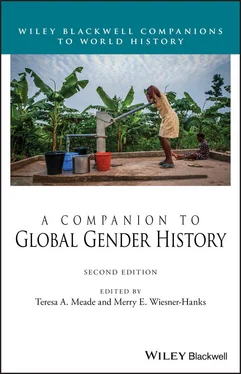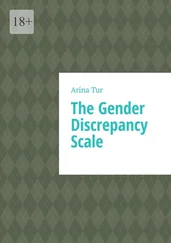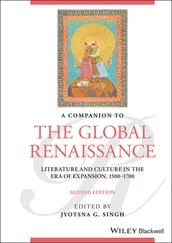We could have chosen any number of images that point to the past, present, and future of gender because, perhaps even more than when the first edition appeared a decade ago, gender is everywhere on the international stage. As chapters by Patricia Acerbi, Barbara Winslow, Charles Sowerwine, Patricia Grimshaw, and others in this book point out, feminism has grown in strength in many quarters of the world. It is challenging male authority on the playing field, in the courts, in entertainment and the media, and in the upper echelons of power, as women seek gender equality. The largest protest demonstration in the history of the world, the Women’s March of 2017, brought millions into the streets, while the spread of #MeToo has empowered women in many fields. On the other hand, as many of our authors note, growing nativist and nationalist movements across the globe have also unveiled the enduring strength of misogyny, especially as it intersects with racism. The wage gap persists, and only a small percentage of women reach top leadership positions in government and business. Even the impact of the 2020 worldwide pandemic has been shaped by gender: incidents of domestic violence against women and children rose precipitously in households where multiple family members were confined for weeks to prevent the spread of contagion; workers in hospitals, nursing homes, and other care facilities most at risk of exposure to the virus were – and are – disproportionately female; women also predominate in the low‐wage service jobs that are impossible to do from home or while maintaining the “social distancing” that the COVID‐19 pandemic requires. Female national leaders, including New Zealand’s Jacinda Ardern, Germany’s Angela Merkel, Finland’s Sanna Marin, and Taiwan’s Tsai Ing‐wen, also did better than their male counterparts at fighting the virus, with much lower death rates and better infection control. The countries with the highest death rates were all led by authoritarian men more concerned with projecting their masculinity than protecting public health.
The prominence of gender in historical scholarship matches its visibility on the world political stage. More than thirty years ago Joan Wallach Scott argued in the pages of the American Historical Review that history was enacted on the “field of gender.” Scott defined gender as “a social category imposed on a sexed body,” and stated, in a line that has since been quoted by scholars in many fields, that “gender is a primary way of signifying relations of power.” 1 Scott later explained that she had originally wanted to pose the salience of gender to historical analysis as a question, but the editors of the American Historical Review would not allow questions in article titles. 2 In the decades since her article appeared, that salience has become clear. Gender – understood as a culturally constructed, historically changing, and often unstable, system of differences – has become a standard category of historical analysis for many younger historians, and a fair share of older ones as well. The women’s history on which gender analysis was initially based has continued to flourish and expand.
What has also happened in the last thirty years is that historical gender analysis and women’s history have increasingly become international enterprises, in terms of both the focus of scholarship and the scholars involved. While the footnotes in Scott’s article – and most other theoretical discussions of gender from the 1980s – were numerous and wide‐ranging, almost all of them referred to studies of the United States or Europe. Since then, new research has begun to challenge understandings of gender derived primarily from the Western experience, and examine the role of women and of gender in global processes. Because of this, we decided to slightly retitle this second edition, adding Global and making it A Companion to Global Gender History .
For this second edition, every chapter has been updated since the first edition, along with the inclusion of seven new authors and seven completely new chapters reflecting topics that have becoming increasingly important in the last decade, including material culture, science, and global imperialism. Written by authors from across the English‐speaking world, the book includes a diversity of viewpoints and reflects questions that have been explored in different cultural and historiographic traditions, thus providing an overview of gender history worldwide. We have attempted to decenter the West, locating Western Europe and North America as simply one of many social formations within a gendered world history that expands from many hubs. As both scholars and teachers, the contributors understand the importance of making difficult concepts understandable, providing evidence for complex assertions regarding gender identity, and grappling with evolving notions of gender construction. We have sought to preserve the features readers praised in the first edition, including balanced coverage of the field of women’s and gender history. In this way the book contributes to the history of women, studying their interactions with men in a gendered world, and also explores the role of gender in shaping human interaction over thousands of years. Each chapter includes suggestions for further reading that give readers the necessary tools to pursue a subject further.
When thinking about how to organize such an enormous project, we decided that it would be useful for readers to have both thematic chapters that provide conceptual overviews of the ways in which gender has intersected with other historical topics and categories of analysis, and more traditional chronological–geographic chapters that explore gender in one area of the world during a specific period (though these are of necessity very broad). We could not cover every part of the world in every time period in a single volume, but we provide enough chapters in each period to allow comparisons between different regions of the world, and enough chapters about one area to allow the tracing of change over time within it. We gave the authors a relatively free hand to explore their particular topic in the way they saw fit, celebrating differences as useful examples through which to assess the ways in which insights in one area can challenge received wisdom and standard generalizations in another.
One of the key points emerging from this collection is that no generalization about gender has applied to all times or all places. Indeed, even Scott’s definition of gender as “a social category imposed on a sexed body,” while acceptable thirty years ago when scholars were asserting the difference between “cultural” gender and “biological” sex, is today highly contested. As the chapter by Deirdre Keenan examines in more depth, intersex and trans individuals have challenged the notion that gender is based on the body. They highlight the nebulous boundaries and permeable nature of the categories “women” and “men,” and challenge us to think carefully when using these words. Historical and anthropological research from around the world has similarly provided evidence of societies in which gender was not based on body parts or chromosomes, but on something else. Sometimes this was a person’s relationship to reproduction, so that adults were gendered male and female, while children and old people were regarded as different genders, and one’s gender thus changed over the span of a lifetime. In some societies gender may have been determined by one’s role in production or religious rituals, with individuals who were morphologically (that is, physically) male or female regarded as the other gender, or as members of a third or even fourth or fifth gender. Marcia‐Anne Dobres suggests that there is evidence for third genders as early as the Mesolithic period (10,000 BCE), Kumkum Roy discusses destabilization of binary gender categories in the Jain tradition, and Rosemary Joyce explores gender fluidity in the early Americas, as does Barbara Andaya in early modern Southeast Asia. Robert Nye notes the continuing power of the two‐gender system, however, and analyzes the ways notions of gender intertwined with those of sexuality.
Читать дальше












